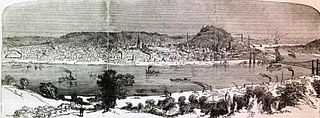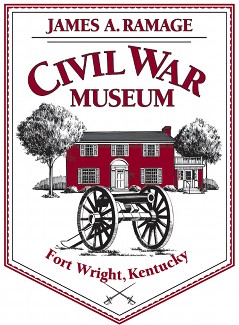The Orphan Brigade was the nickname of the First Kentucky Brigade, a group of military units recruited from Kentucky to fight for the Confederate States of America during the American Civil War. The brigade was the largest Confederate unit to be recruited from Kentucky during the war. Its original commander was John C. Breckinridge, former United States vice president, and Kentucky's former senator, who was enormously popular with Kentuckians.

The 1st Ohio Infantry Regiment was an infantry regiment in the Union Army during the American Civil War. It served in the Western Theater in a number of campaigns and battles.

During the American Civil War, the State of Ohio played a key role in providing troops, military officers, and supplies to the Union army. Due to its central location in the Northern United States and burgeoning population, Ohio was both politically and logistically important to the war effort. Despite the state's boasting a number of very powerful Republican politicians, it was divided politically. Portions of Southern Ohio followed the Peace Democrats and openly opposed President Abraham Lincoln's policies. Ohio played an important part in the Underground Railroad prior to the war, and remained a haven for escaped and runaway slaves during the war years.
The 2nd Ohio Infantry Regiment was an infantry regiment in the Union Army during the American Civil War.

Louisville in the American Civil War was a major stronghold of Union forces, which kept Kentucky firmly in the Union. It was the center of planning, supplies, recruiting and transportation for numerous campaigns, especially in the Western Theater. By the end of the war, Louisville had not been attacked once, although skirmishes and battles, including the battles of Perryville and Corydon, Indiana, took place nearby.

The Defense of Cincinnati occurred during what is now referred to as the Confederate Heartland Offensive or Kentucky Campaign of the American Civil War, from September 1 through September 13, 1862. Confederate Brigadier General Henry Heth was sent north from Lexington, Kentucky, to threaten Cincinnati, Ohio, then the sixth-largest city in the United States. Heth was under orders from his superior, Major General Edmund Kirby Smith, not to attack the city, but to instead make a "demonstration". Once Heth arrived and reconnoitered the defenses, he realized an attack was pointless. After a few minor skirmishes, he took his men back to Lexington.

The 104th Ohio Infantry Regiment, sometimes 104th Ohio Volunteer Infantry, was an infantry regiment in the Union army during the American Civil War. It played a conspicuous role at the Battle of Franklin during the 1864 Franklin–Nashville campaign, where six members later received the Medal of Honor, most for capturing enemy flags.

Powhatan Beaty was an African American soldier and actor. During the American Civil War, he served in the Union Army's 5th United States Colored Infantry Regiment throughout the Richmond–Petersburg Campaign. He received America's highest military decoration, the Medal of Honor, for taking command of his company at the Battle of Chaffin's Farm, after all officers had been killed or wounded.

During the American Civil War, the Ohio River port city of Cincinnati, Ohio, played a key role as a major source of supplies and troops for the Union Army. It also served as the headquarters for much of the war for the Department of the Ohio, which was charged with the defense of the region, as well as directing the army's offensives into Kentucky and Tennessee.
The 3rd Ohio Infantry Regiment was an infantry regiment in the Union Army during the American Civil War. It served in several important campaigns in the Western Theater in Kentucky, Tennessee, and Alabama.

The 24th Ohio Infantry Regiment was an infantry regiment in the Union Army during the American Civil War. The regiment was known for its daring and professional behavior, often arriving first into the battle and acting as the vanguard in its brigade. In its first battle, the 24th Ohio and the 14th Indiana, with around 300 soldiers fit for duty, defended the Cheat Mountain Summit Fort from around 4,500 Rebels in Anderson's Brigade, Rust's Brigade, and Gen. H. R. Jackson's brigade, leading to a disastrous defeat for Confederate General Robert E. Lee. The regiment played "The Star-Spangled Banner" during the Battle of Shiloh, and lost almost all of its commissioned officers in the Battle of Stones River. The 24th Ohio suffered its only defeat on the battlefield at the Battle of Chickamauga.
The 59th Ohio Infantry Regiment was an infantry regiment in the Union Army during the American Civil War.
The 60th Ohio Infantry Regiment was an infantry regiment in the Union Army during the American Civil War.
The 114th Ohio Infantry Regiment, sometimes 114th Ohio Volunteer Infantry was an infantry regiment in the Union Army during the American Civil War.

Battery I, 1st Ohio Light Artillery was an artillery battery that served in the Union Army during the American Civil War. It was also known as Dilger's Battery.
The 48th Ohio Infantry Regiment was an infantry regiment in the Union Army during the American Civil War.

The 82nd Ohio Infantry Regiment, sometimes 82nd Ohio Volunteer Infantry was an infantry regiment in the Union Army during the American Civil War.
The 83rd Ohio Infantry Regiment, sometimes 83rd Ohio Volunteer Infantry was an infantry regiment in the Union Army during the American Civil War. It was nicknamed "The Greyhound Regiment".

William Martin Dickson, also known as William M. Dickson (1827–1889), was a lawyer, prosecuting attorney, and judge from Cincinnati, Ohio, United States. He was one of the founders of the Republican Party and assisted in the framing of the Emancipation Proclamation. Alphonso Taft, the father of President and Chief Justice William Howard Taft, and Thomas Marshall Key were his law partners.




















